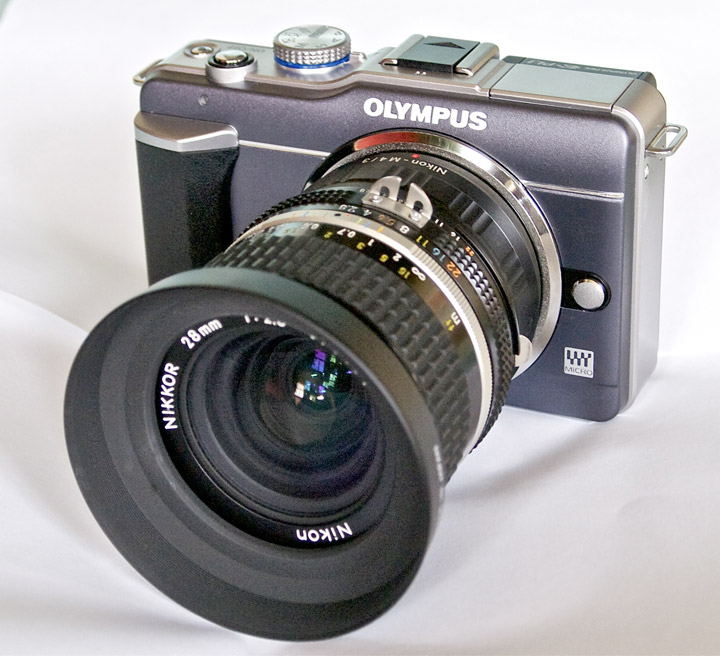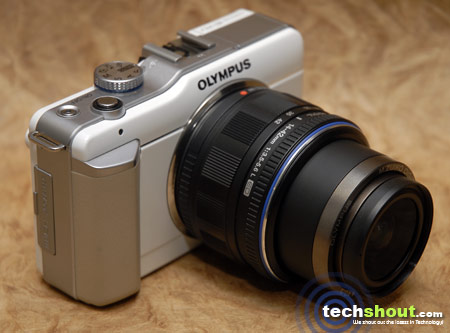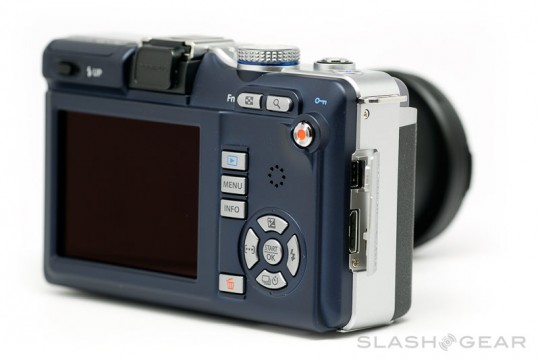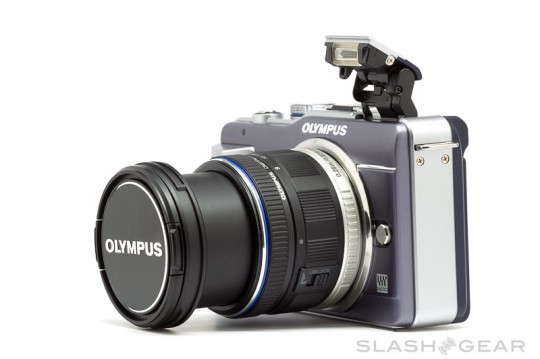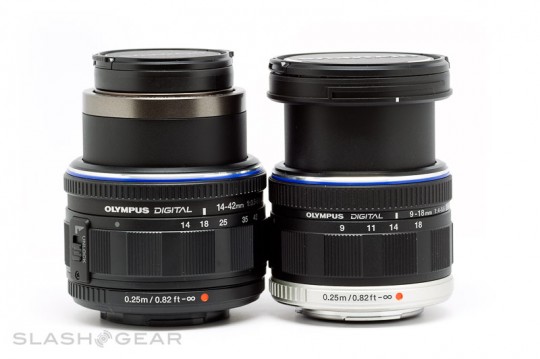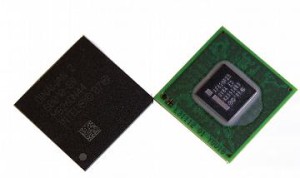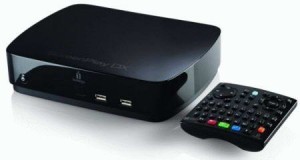A camera is normally looked upon as a nifty little thing which you can carry around in your pocket, slip it into your purse or dump it into your back-pack. Well, the digital device we are reviewing today cannot be pocketed but will surly cater to your photography fetish. The Olympus Pen E-PL1 takes you back to your retro roots and may even remind you of your first film camera as it sports that very same bulky appearance and weight. However do not be fooled by its size and don’t go pitting it against your slim digital camera gifted by your aunt……….
The Olympus Pen E-PL1 gives you the benefit of a large imaging sensor and interchangeable lenses while keeping the required bulk to a reasonable minimum. This allows you to have all the attributes found in a DSLR camera without needing to cart along a huge load. The device comes bundled with a Micro Four Thirds M.Zuiko 14-42mm zoom lens which is again easy to utilize. It smoothly twists into the front of the camera and can easily be detached by pressing a small button located on the right side of the camera. Offering users amazing 12.3 megapixels, the company also brings to the table other highlights such as one-touch HD Video and new Live Guide. We obtained the white colored model complete with silver thick line running along the edges and a beige protrusion which offers a great textured grip while capturing footage. The camera can even be acquired in two more colors namely champagne gold and black.
Nicephore Niepce, without two thoughts, nailed bags of appreciation for using a sliding wooden box camera to capture the first photography way back in 1814. From a simple one megapixel moment capturer to a heavy 14 megapixel one, cameras have witnessed a significant evolvement over the years. With preferences changing like a blue streak, Olympus doesn’t mind endeavoring to entice photography aficionados. The half-frame cameras crafted by this smart wit fell light on both the weight and size of the Olympus Pen. The Pen was a compact amalgam of innovative ideas that plunged into the half-frame upsurge of the 1960s and 1970s.
Micro-four-thirds cameras may be small in your pocket but their impact on your pocketbook can often still be significant. Stepping into the budget micro-4/3 market is the Olympus Pen E-PL1.
The Micro Four Thirds “semi-compact” digital camera system is catching on, accounting for more than 10% of interchangeable-lens camera sales in December last year, according to market research firm GfK.
No surprise, then, that barely eight months after Olympus’ maiden Micro Four Thirds-based, retro-styled PEN E-P1 comes a new variant. This model complements the existing E-P1 rather than replacing it, but it’s a very similar design indeed, albeit 72g lighter.
The most useful addition is an integrated flash. While not hugely powerful, it pops up on a well-built, double-jointed arm that moves it well away from the centre line of the lens to keep the dreaded red-eye at bay. A touch of fill-in flash can also work wonders for shots such as outdoor portraits in strong sunlight, so it’s a useful addition.
After creating a whirlwind in the digital world with the E-P1 Micro Four Thirds interchangeable lens camera, Olympus made headlines once again with its, yet another, attractive digital offering. Yes, we couldn’t nod to the left or right when the E-PL1 asked us to review it. So read on as we divulge in this canvass as what captured our hearts and what made us raise our brows.
The front of the device is littered with just the company’s name in black bold letters and hogging up majority of the place is a wide lens opening that can be paired with Micro Four Thirds glass. Also featured on the face of the camera is the lens release button and self-timer light. Adorning the top of the device is the on/off button which emits a blue light when in standby mode as well as a shutter button, mic, slot for an individual flash, Live Finder or a Microphone Adapter and a thick mode dial. Taking the cake in this section is the concealed pop-up flash which must be activated manually with a slide button located on the back of the camera. Coming back to the mode dial, we see it sporting the options iAuto, Program, Aperture and Shutter speed, full manual, Movie, Scene with 19 options and Art. We shall explore and divulge into these factors in just a bit.
This 12.3 megapixel camera popped out of a big equilateral box while a rechargeable Li-ion battery, battery charger, and lens dozed composedly there. As first impression is always the last impression, the E-PL1 didn’t dash our hopes with its mannerly looks. The handy device sports a sedate yet stylish chassis which made us crave for some luminosity without any hemming and hawing. Though slightly paradoxical to vivacious, the company played a game and dabbed it in different hues of black, white and champagne gold, ensuring that your taste for unique shades stays alive. Scaling at 4/3-inch, the good-looking camera now avoids the need to piggyback those heavy DSLR cameras around with its compact size featuring all the essential attributes found on a huge professional camera. Olympus fetches credit for nurturing your photography enthusiasm with a commendable blend of lightweight body and impressive features. To your advantage, if anyone thinks of sliding it in their bag without your ‘go-ahead’, its non fingerprint-resistant 2.7-inch HyperCrystal LCD display with Anti-Reflective coating could successfully clue in about the guilty. With a weight of just 133g, the device is quite portable though not compact enough to fit into a pair of regular denims.
The rear of the Olympus Pen E-PL1 camera features a 2.7 inch HyperCrystal LCD monitor which was bright enough to view content even in sunlight. Alongside this were the dedicated play, Menu, Info and delete buttons. There is also a four-way controller with the OK button located at the center. The options here allow you to gain access to flash, exposure compensation, burst shooting and metering zone with the speaker sitting plush above these buttons. On the right side edge is a concealed compartment for USB and HDMI while the bottom of the camera consists of a tripod mount and dual compartment that neatly houses the rechargeable battery pack and SD card slot. The components in the box include three lens caps, one for the lens opening and two for the provided Micro Four Thirds lens. It also comes bundled along with a Li-ion battery charger BCS-1 and USB/Video Multi cable.
High quality pictures can be captured by setting the mode dial to iAuto and simply letting the camera do the rest. The i-Enhence automatically analyzes the scene and adds the appropriate shooting mode depending on the subject and environment. But if you wish to further customize the picture of your muse then simply press the start button and voila, there is a whole line-up of options such as change color saturation, color image, brightness, background, express motions and shooting tips at your disposal. This customization option is called the Live Guide which is certainly a feature to look out for in this camera. We found the ’shooting tips’ rather helpful and believe that it would certainly appeal to photography enthusiasts who love to capture a plethora of still pictures.
As mentioned above, there is a dedicated Movie mode button which offers you 720p HD movie recording. The footage obtained is crystal clear while the voice and background sound are very audible. The device also enables you to start recording a video almost instantaneously. They can even be captured without the mode dial being on Movie mode. This can be accomplished with a simple press of the dedicated red circular recording button located on the back of the camera. Through this option, you can also easily toggle between still image and movie shooting.
There are six Art Filters for shutter-bugs to take complete advantage of such as gentle Sepia, Pop Art, Soft Focus, Grainy Film, Pin Hole and Diorama. In scene mode, you have 19 categories to choose from. These include portrait, e-potrait, landscape, land + pot, sport, night scene, nite+ pot, children, high key, low key, Dis mode, macro, nature macro, candle, sunset, documents, panorama, fireworks, beach and snow. Something for every occasion, situation, and personal preference ranging from a candlelit dinner to the fourth of July or even sports day at school.
Olympus has also endowed this digital camera with a dedicated one-touch Enlarge button. When pressed once, it displays an enlarged view and on further hitting the button, a complete full-frame field of view is obtained. There is even a high-performance image stabilization system integrated into the system which avoids blurring due to camera shake. While viewing your pictures through the camera’s LCD display, you are even given an option to enjoy them in a smooth slideshow mode. The videos can also be enjoyed through the clear monitor with sound options being available directly on the camera.
We also liked the camera’s simple, intuitive control layout with large buttons which made it super-easy for us to operate a technical interchangeable lens camera like this. Then on, we appreciated its Continuous-Tracking AF function that automatically tracks subject movement within the frame. Impressively, we could also detect up to 8 faces and optimize focus, thanks to its advanced Face detection technology. Olympus further empowered its digital camera with a dedicated one-touch Enlarge button. When pressed once, it represents a broadened view and on further hitting the button, a complete full-frame field of view is achieved. Apart from this, we were able to enjoy blur free photographs, undeterred by our shimmy hands, with a top-notch image stabilization system.
Olympus were keen to remind us on numerous occasions that the E-PL1 is tailored for beginners seeking out a prosumer camera capable of high image quality on a budget, and the i-Auto mode is built specifically for that. The Live Guide mode uses basic language for the menus and allows amateurs to tweak saturation, white balance, brightness, background blur and express motion, with the effect of their settings shown in the live view preview before the picture is taken. On-screen guidelines and tips give hints on how best to compose the shot and what sort of settings might benefit from adjustment. Perhaps the most interesting feature is the “express motion” setting, which simulates a motion blur effect on the LCD screen which more advanced photographers would recognize as panning blur. Usually you’d have to play with lower shutter speeds to create a directional blur effect, but the E-PL1 does a fair approximation itself. Unfortunately, even if you’ve found your new favorite settings in i-Auto, they’re only applied once to that particular shot.
The camera goes from boot-to-ready in little over a second, with focusing speed almost instantaneous when in decent ambient lighting using both the 9-18mm and 14-42mm lenses we tested. In low light, it hesitates but not enough to upset an impatient photographer more used to a powerhouse DSLR. In extreme low light and low contrast situations, it didn’t perform any worse than a professional DSLR costing 10 times as much. Overall, focusing speed is fast and reliable.
Image stabilization is sensor-based and can compensate up to 3 stops; it proved especially useful in low light situations without tripod support. We were able to capture San Diego bay’s last light as low as 1/4 s while maintaining usable sharpness. The PEN provides three user-selectable modes of stabilization: Mode 1 for general shooting, Mode 2 for creative high-speed horizontal capture, and Mode 3 for high-speed vertical capture. Meanwhile there’s also Olympus’ SuperSonic Wave Filter system, which shakes any dust particles from the image sensor.
Image sharpness has more to do with lenses than with cameras; however, the low-pass aka anti-alias filter placed in front of the image sensor does affect the outcome of the image. In the case of the E-PL1, a weaker filter is used thus it actually handles sharpness a little better than its predecessors. We tried the ZUIKO Digital ED 14-42mm and M.ZUIKO Digital ED 9-18mm ultra wide angle lenses for our review. The former is an entry-level kit lens with plastic construction, and it both looks cheap and feels cheap as though it might fall apart after a single drop. The latter, on the other hand, is a better-built wide angle lens with a with metal mount; like the 14-42mm, it’s a light weight, compact ultra angle with plastic components, but you can definitely tell the difference in quality holding both in your hands. Unlike the 14-42mm, the 9-18mm zoom mechanism doesn’t wobble as you move the inner tube back and forth. As for lens construction, you’re looking at 12 elements in 8 groups, 3 aspherical and 1 ED element construction vs 10 elements in 8 groups, 2 Aspherical and 1 ED element.
On the 9-18mm, image distortion at the widest ends is acceptable, and there’s minimal to no chromatic aberration displayed at the center of the lens but quite visible at the very corners. The same result was observed for image sharpness, but overall it’s a respectable ultra wide angle lens considering the price tag of $475. The compact design is great for landscaping and dropping in a bag while on vacation. Particularly worth mentioning is the lack of vignetting from a 35mm equivalent of 18mm-36mm.
The Olympus Pen E-PL1 camera offers you a complete retro look embedded with loads of stunning features that can be expected in any DSLR camera or HD camcorder. The latest Olympus offering is your portal to capturing all the fun and snazzy pictures as well as bright reliable video in complete HD. It’s a perfect addition to any holiday or even great for special occasions or capturing everyday life in HD. The camera can even be paired with any Micro Four Thirds System lens. With its one-touch video mode and Live Guide options, we give this camera an 8.7 out of 10.
Specifications:
- 12 megapixels.
- 2.7-inch LCD monitor.
- Micro Four Thirds format.
- 720p HD video.
- RAW + JPEG file format.
- Built-in flash.
- Accessory port for electronic viewfinder, microphone.
- In-body image stabilization.
- 14-42mm f/3.5-5.6 lens included.
- Captures to SD/SDHC memory cards.
- Rechargeable lithium-ion battery.
Resources :techshout.com,techgadgets.in,slashgear.com




